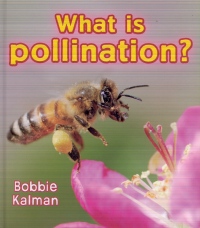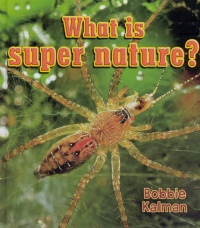| ________________
CM . . .
. Volume XVII Number 27. . . .March 18, 2011 
 |
What Is Pollination? (Big Science Ideas).
Bobbie Kalman.
St. Catharines, ON: Crabtree, 2011.
32 pp., pbk. & hc., $9.95 (pbk.), $20.76 (RLB.).
ISBN 978-0-7787-3306-5 (pbk.), ISBN 978-0-7787-3286-0 (RLB.).
Subject Heading:
Pollination-Juvenile literature.
Grades 2-3 / Ages 7-8.
Review by Gail Hamilton.
*** /4
|
| |
|
 |
What Is Super Nature? (Big Science Ideas).
Bobbie Kalman.
St. Catharines, ON: Crabtree, 2011.
32 pp., pbk. & hc., $9.95 (pbk.), $20.76 (RLB.).
ISBN 978-0-7787-3307-2 (pbk.), ISBN 978-0-7787-3287-7 (RLB.).
Subject Headings:
Natural history-Juvenile literature.
Nature-Juvenile literature.
Grades 2-3 / Ages 7-8.
Review by Gail Hamilton.
**½ /4
|
| |
|

excerpt:
Termites are insects. Some termites make huge homes called mounds. Termite mounds can be as tall as 30 feet (9 meters). These homes are even more amazing inside! Termites build mounds that always stay about the same temperature. The queen of the colony, or community, directs the building of the mound by giving off scent, or smell, messages. The workers build the mounds using mud and their saliva, or spit. The termites keep the mounds at the same temperature by opening and closing heating and cooling vents during the day and at night. (From What is Super Nature?)
Currently numbering 14 volumes, the "Big Science Ideas" series is designed to teach readers about plants and animals. These titles are the newest additions to the series. Comprised of 14 chapters, the books generally have one paragraph per page and plenty of vibrant colour photographs, as well as a few diagrams and drawings, to support the text. The concepts are explained simply in kid-friendly language. Some of the words in boldface type are defined where they appear in the book while others are explained in the glossary. Perhaps it would have been better to print in boldface only the words that appear in the glossary to avoid confusion. A table of contents and an index are included. Of the two titles, What is Pollination? is the better one because it focuses on a single idea and provides greater detail whereas the second title gives general information about a variety of "super powers" of plants and animals.
One-third of the food that humans eat depends on pollinators. In What is Pollination? readers will learn the differences to be found among cross, self and wind pollination, the parts of a flower, how plants make food, and about the decimation of pollinator numbers due to pesticides, diseases, parasites and habitat encroachment. Several types of pollinators, and their specialized body parts that gather pollen or drink nectar, are also featured, like bees, butterflies, moths, wasps, flies and beetles, as well as small animals, such as birds (over 2,000 kinds feed on nectar), bats, lizards and possums. Readers will also find out about how a flower's colour, scent or special markings attract pollinators.
"Super nature" refers to the many things that animals and plants can do that humans cannot. Some of the topics included in What is Super Nature? photosynthesis, food chains, the importance of eating natural (and not processed) foods, pollination, animals' natural ability to heal themselves, spider silk, migration and communication, such as luminescence and echolocation. Because there are so many topics, the text just skims the surface and provides a few examples of each of the "super powers" that animals and plants possess. One example that children might find interesting is that elephants can hear infrasound (sounds too low for humans to hear) and that they can send messages to other elephants as far away as 50 km by stomping their feet. The last couple of chapters focus on eco-friendly ideas, such as conserving energy, composting, recycling, and growing fruits and vegetables. Though this book has some merit, there is somewhat of a disconnect between the definition of "super natural" as it applies to plants and animals and as it applies to humans.
Potential buyers of titles in this series would be wise to examine individual titles carefully before purchase.
What is Pollination? Recommended.
What is Super Nature? Recommended with reservations.
Gail Hamilton is a retired teacher-librarian in Winnipeg, MB.

To comment
on this title or this review, send mail to cm@umanitoba.ca.
Copyright © the Manitoba Library Association. Reproduction for personal
use is permitted only if this copyright notice is maintained. Any
other reproduction is prohibited without permission.
NEXT REVIEW |
TABLE OF CONTENTS FOR THIS ISSUE
- March 18, 2011.
AUTHORS |
TITLES |
MEDIA REVIEWS |
PROFILES |
BACK ISSUES |
SEARCH |
CMARCHIVE |
HOME |

